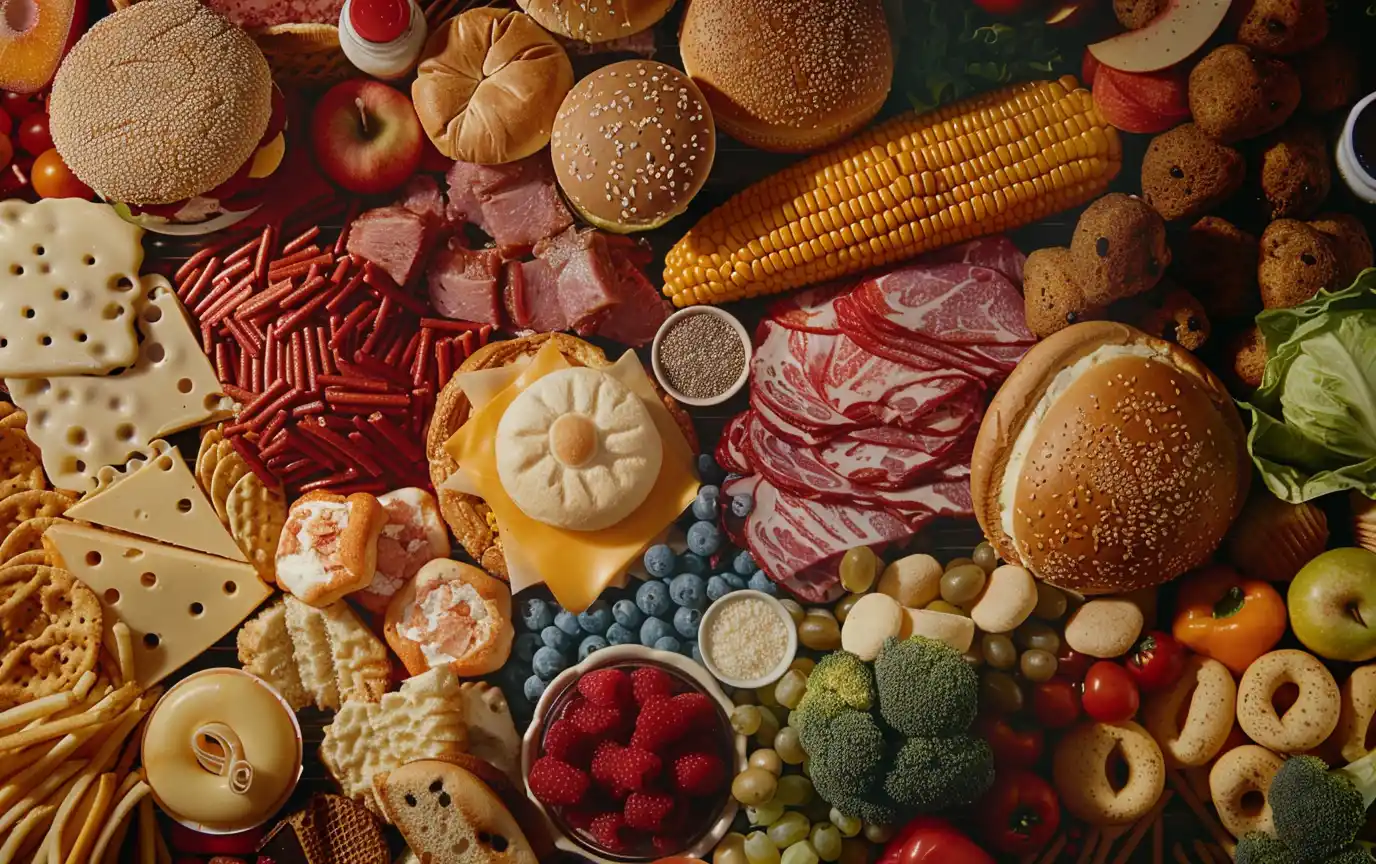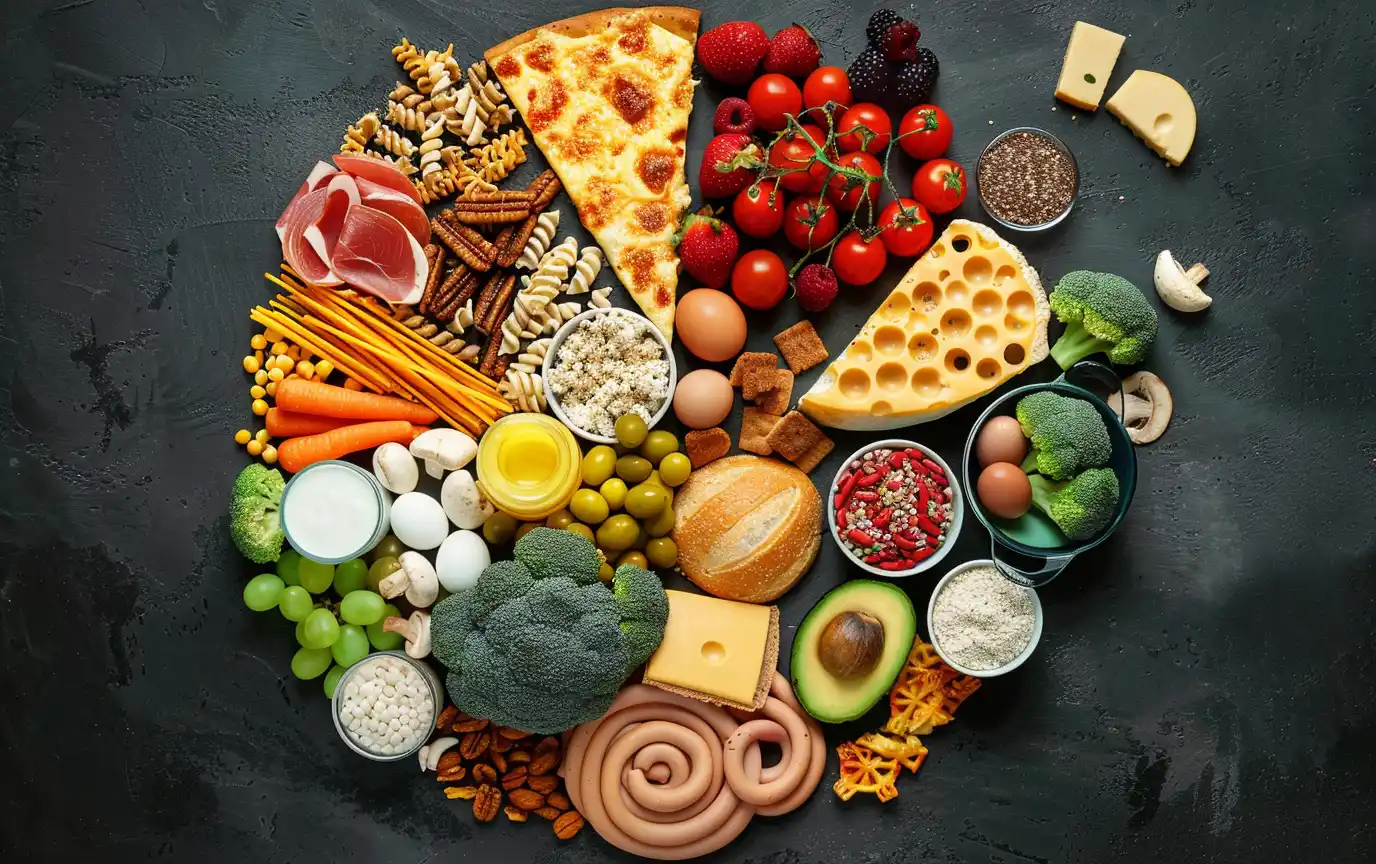

Understanding Calories: The Basics of Energy Intake and Expenditure
Proper calorie intake is crucial for maintaining a healthy weight and achieving weight loss goals.
How can we understand calories, calculate daily needs, and develop effective strategies for weight management?

What are calories and Why Do They Matter?
To begin with, let’s immediately clarify that a person does not eat and does not consume calories, as is often written in the media.
The caloric content of the diet is its energy value, i.e., a conventional value that reflects how much energy a particular product gives us and how much is spent by the body.

For those who have forgotten physics: 1 kilocalorie (1,000 calories) is the amount of heat required to heat 1 liter of water by 1 degree Celsius.
That is, one of the main functions of nutrition is energy. If we get more kilocalories with food (proteins, fats, and carbohydrates) than we spend, we gain weight.
And vice versa: if you spend more, then you lose weight (the difference should be at least 300 kcal per day).
Kilocalories are the alpha and omega of proper nutrition.
It is possible, and sometimes even necessary, to forget about fashionable diets, nutrition systems, and meal hours, but to gain knowledge about the basics of human energy metabolism.
Then your chances of losing weight will increase rapidly.

Calculating Your Daily Calorie Needs: Factors and Formulas
So what and how many kilocalories do we spend on?
First of all, to ensure the constant functioning of all our organs and systems, to maintain a constant body temperature, to the synthesis of hormones, neurotransmitters, enzymes, etc. It is approximately equal to one kilocalorie per 1 kg of body weight per hour.
Multiply your weight by 24 hours, and you get the minimum daily intake of kilocalories.
So, a person with a body weight of 70 kg needs 1680 kcal per day to maintain life.
However, this formula for calculating kilocalories needs to be adjusted, because we are at rest only at night, when we sleep.
Any daytime activity and other factors – physical work, cold weather, emotional stress, etc. – increase energy expenditure.
That is why correction factors are used to calculate human needs in kilocalories. And the more intense the load, the higher they will be.
For example, in sedentary work, the coefficient is 1.43 (in a sitting position, we spend 1.43 kcal per 1 kg per hour), and in a fast walk (6 km/h), the coefficient will already be 4.28.
Step-by-Step Guide to Calculating Your Daily Calories Needs
Let’s make a formula for calculating the need for kilocalories using a conditional example:
- A person weighing 70 kg, engaged in sedentary work, spends about 70 kcal/hour on basal metabolism.
- For 12 hours of wakefulness, this is 840 kcal.
- Multiply this figure by a coefficient of 1.43 and get 1201 kcal.
- There are still 12 hours of a conditional night in the day, when energy expenditure is approximately equal to the basal metabolism (this is another 840 kcal).
- We add 1201 + 840.
As a result, we get that the daily energy expenditure of a person weighing 70 kg, leading a sedentary lifestyle, does not exceed 2041 kcal.
Approximately as much as they should get with food – 2000-2100 kcal. But this is provided that they are not overweight and even more so obese.

Energy Expenditure: How Different Activities Affect Calorie Burn
To give you a better understanding of how different activities affect calorie burn, here’s a table showing energy expenditure for various activities:
| Activity | Energy expenditure (kcal per hour per 1 kg) |
| Sleep | 0.93 |
| Lying without sleeping | 1.1 |
| Sitting | 1.43 |
| Standing | 1.5 |
| Reading aloud | 1.5 |
| Hand sewing | 1.59 |
| Knitting | 1.66 |
| Dressing and undressing | 1.69 |
| Singing | 1.74 |
| Typing on the keyboard at a fast pace | 2 |
| Dishwashing | 2.06 |
| Cleaning the house | 2.41 |
| Slow walking | 2.68 |
| Morning gymnastics | 3 |
| Work of a carpenter, metallurgist, carpenter | 3.43 |
| Work of a bricklayer | 5.71 |
| Swimming at a slow pace | 7.14 |
| Ice skating 203 m/min | 7.8 |
| Slow running, 8 km/h | 8.14 |
| Skiing | 9.28 |
| Running 200 m/min | 9.5 |
| Cycling | 9.7 |
| Swimming: 47.2 m/min | 10.3 |
| Cross-country skiing 131 m/min | 12 |
| Wrestling | 16 |
People with a sedentary lifestyle (and this is everyone who does not reach the level of physical activity of a carpenter, metallurgist, and even more so an athlete) are recommended to use a coefficient of 1.5 and a period of time of 10-12 hours to simplify the calculation of the consumption of the average rate of kilocalories per day.

Personalized Calorie Intake: Factors Influencing Your Weight Loss Journey
Calculating the necessary calorie content of the diet is a complex matter, as not everything is determined by simple arithmetic.
Age, Gender, and Metabolism: Key Factors in Calorie Requirements
Several factors influence your calorie needs and weight management:
- Metabolic rate: People have different metabolic rates, which are genetically determined. Some individuals efficiently use energy from food, while others store it as fat.
- Age: A child’s metabolism is faster than that of an adult, and even more so an elderly person. This means that the calorie norm for them will be different.
- Hormonal balance: Thyroid hormones play a crucial role in metabolism. An imbalance can affect weight management efforts.
- Gender: For women and men, even with the same excess of the body mass index, an individual approach is required in this matter.
- Psychological state: Stress and anxiety can influence appetite and eating behaviors, potentially leading to overeating.
To determine what calorie intake will be optimal per day, a person’s gender and age matter. For women and men, even with the same excess of the body mass index, an individual approach is required in this matter.

Hormonal Influences on Weight Management
So, in women during the transition to menopause (menopause), the ovaries gradually stop producing sex hormones estrogens. The same hormones, but in smaller quantities, are synthesized in adipose tissue. The body seeks to increase its amount to partially compensate for the lack of estrogens.
Therefore, a woman at the age of about 50 will have to reduce the calorie content of the diet much more than a 30-year-old man with the same number of extra pounds.
Due to the increase in physical activity, it will be much easier for him to lose weight, even eating more high-calorie food than a lady of post-Balzac age.
The calorie norm per day can be calculated using a calculator, including programs on the Internet.
They take into account gender, age, weight, height, and degree of physical activity. This is the right approach, but very average.
The recommendations obtained in this way should not be taken as a guide to action.
Remember that the female calorie norm per day, as well as the norm for a man (teenager, child), is determined by many different factors. In order not to make a mistake, it is best to consult a dietitian.
Calorie Reduction Strategies: Effective Tips for Sustainable Weight Loss
What should be the norm of calories per day received with food to lose weight?
This question worries many. At first glance, it seems that less is more. However, this is a big mistake – you should not starve yourself in any case!
Even if at first you quickly lose a little weight on a strict diet, then soon the loss of extra pounds will slow down, or even stop.
This is a feature of our metabolism: with a decrease in the intake of nutrients, the body goes into economy mode, i.e., it begins to spend less energy than before. At the same time, some complain of chilliness, drowsiness, and fatigue.
Smart Calorie Reduction: Finding Your Optimal Intake for Weight Loss
To do everything right, you need to calculate how many calories you need individually and subtract 20% from the resulting figure.
So, if on average a woman should receive 2000-2200 kilocalories daily with different foods, then an average of 1600-1800 will be enough to lose weight.
Similarly, it is easy to calculate the calorie norm per day for weight loss and for men: 2000-2160 kcal instead of 2500-2700 kcal.
Practical Tips for Successful Calorie Management and Weight Loss
- Focus on nutrient-dense foods: Choose foods that provide essential nutrients with fewer calories, such as fruits, vegetables, lean proteins, and whole grains.
- Practice portion control: Use smaller plates and measure your food to avoid overeating.
- Stay hydrated: Drink water before meals to help you feel fuller and potentially eat less.
- Increase physical activity: Incorporate regular exercise into your routine to burn more calories and boost metabolism.
- Keep a food diary: Track your calorie intake and eating habits to identify areas for improvement.
- Plan your meals: Prepare healthy meals in advance to avoid impulsive, high-calorie food choices.
- Get enough sleep: Adequate sleep helps regulate hormones that control hunger and appetite.
- Eat mindfully: Pay attention to your food, eat slowly, and savor each bite to help you feel more satisfied with less.
Calorie Content vs. Nutritional Value: Choosing the Right Foods for Weight Loss
It is also important to determine with which products you will receive the necessary energy. The calorie content of products and their nutritional value are not the same thing.
For example, 100 g of cucumbers is 8-10 kilocalories. Therefore, eating 2 kg of cucumbers, a person receives 200 kilocalories.
This is approximately the energy value of one slice of white bread. Of course, spending a fasting day on a cucumber diet, a person will not feel as hungry as if he ate only a piece of bread.
The most optimal diet for those who want to lose weight is protein foods, a variety of vegetables, unsweetened fruits, whole grain products.
But easily digestible carbohydrates – sweets and muffins, as well as fats in any form, should be limited.
Many people are interested in the rate of burning calories per day for weight loss. There are no restrictions with this! The more the better. Here, as they say, all means are good.
But these are not a variety of dietary supplements that are ineffective, but long walks, cycling, jogging, swimming, contrast showers, aerobics – whatever you like best.

The Power of Small Changes: Gradual Weight Loss for Long-Term Success
Remember that most people become overweight as a result of a small but constant excess of their calories.
If you make nutrition rational and reduce this norm slightly, then a slow but sure process of weight loss will begin.
This is exactly how gradual and smooth it should be.
“Gradual weight loss allows you to learn new habits and make lifestyle changes that you can maintain for the long haul.”
Dr. Caroline Apovian, Director of the Nutrition and Weight Management Center at Boston Medical Center




